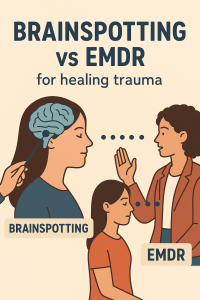
Understanding Brainspotting and How It Differs From EMDR
In the ever-evolving world of trauma therapy, Brainspotting is emerging as a powerful and accessible modality for healing deep emotional wounds. While many have heard of EMDR (Eye Movement Desensitization and Reprocessing), Brainspotting is still relatively new to the mainstream. Yet, its unique approach is making waves—particularly for individuals looking for a more somatic, nonverbal way to process trauma, anxiety, and chronic stress.
Understanding Brainspotting
Brainspotting (BSP) is a therapeutic technique developed by Dr. David Grand in 2003. It works on the principle that “where you look affects how you feel.” By identifying, processing, and releasing sources of emotional pain and trauma stored in the body, Brainspotting accesses the brain’s deeper layers—specifically the subcortical regions responsible for emotion and survival.
During a Brainspotting session, a therapist guides the client to find a specific eye position—called a “brainspot”—that correlates with the activation of traumatic memories or unresolved emotional experiences. Once located, the client maintains that eye position while observing inner sensations, feelings, and thoughts. This allows for deeper access to the nervous system’s trauma stores without the need to overly verbalize experiences.
How Brainspotting Differs from EMDR
While both Brainspotting and EMDR are brain-based therapies designed to heal trauma, they operate differently:
| Aspect | Brainspotting | EMDR |
|---|---|---|
| Focus | Deep subcortical processing using fixed eye position | Bilateral stimulation (eye movements, tapping) to desensitize traumatic memories |
| Client Experience | More open-ended, allows for silence and internal processing | More structured, follows an 8-phase protocol |
| Therapist Role | Follows the client’s neurobiological cues | Guides the client through a step-by-step process |
| Verbalization | Minimal; encourages body awareness | Typically involves more verbal narrative and cognitive restructuring |
Both are evidence-informed and effective for trauma, PTSD, anxiety, and more. However, many clients find Brainspotting especially useful when they feel “stuck” with talk therapy or traditional EMDR methods.
Why Choose Brainspotting?
Accesses trauma stored in the body, not just the mind
Effective for developmental trauma, attachment wounds, performance anxiety, and chronic pain
Suitable for people who struggle to verbalize their trauma
Complements other somatic and mindfulness-based therapies
If you’re searching for EMDR therapy but are curious about new, holistic trauma modalities, Brainspotting might be exactly what you’re looking for.
Changing Tides Counseling: Brainspotting That Takes Insurance
At Changing Tides Counseling, we proudly offer Brainspotting therapy as part of our trauma-informed care services. Located in a supportive and serene environment, our clinicians are trained in both Brainspotting and EMDR, and we believe in tailoring therapy to each person’s unique nervous system.
We understand that financial accessibility matters. That’s why Changing Tides Counseling accepts insurance for Brainspotting sessions—a rare offering in the mental health field. Whether you are just starting your healing journey or seeking deeper work beyond traditional talk therapy, our team is here to guide you.
Schedule a Consultation Today
If you’re considering EMDR or Brainspotting therapy, let’s explore which path is right for you. Reach out to Changing Tides Counseling to schedule a free consultation and take your next step toward lasting healing.
📍Located in Katy, Texas, and serving clients throughout Fulshear, Richmond, Houston, and beyond with in-person and virtual therapy options.
📞 832.303.9419
📧 office@changingtidescc.com
🌐 www.changingtidescc.com